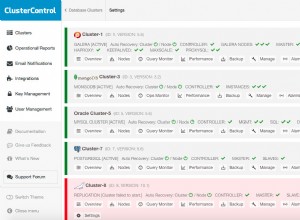.count() è di gran lunga più veloce. Puoi vedere l'implementazione chiamando
// Note the missing parentheses at the end
db.collection.count
che restituisce la lunghezza del cursore. della query predefinita (se count() viene chiamato senza documento di query), che a sua volta viene implementato come restituzione della lunghezza del _id_ indice, iirc.
Un'aggregazione, invece, legge ogni singolo documento e lo elabora. Questo può essere solo a metà dello stesso ordine di grandezza con .count() quando lo fai solo su circa 100k di documenti (dai e prendi in base alla tua RAM).
La funzione di seguito è stata applicata a una raccolta con circa 12 milioni di voci:
function checkSpeed(col,iterations){
// Get the collection
var collectionUnderTest = db[col];
// The collection we are writing our stats to
var stats = db[col+'STATS']
// remove old stats
stats.remove({})
// Prevent allocation in loop
var start = new Date().getTime()
var duration = new Date().getTime()
print("Counting with count()")
for (var i = 1; i <= iterations; i++){
start = new Date().getTime();
var result = collectionUnderTest.count()
duration = new Date().getTime() - start
stats.insert({"type":"count","pass":i,"duration":duration,"count":result})
}
print("Counting with aggregation")
for(var j = 1; j <= iterations; j++){
start = new Date().getTime()
var doc = collectionUnderTest.aggregate([{ $group:{_id: null, count:{ $sum: 1 } } }])
duration = new Date().getTime() - start
stats.insert({"type":"aggregation", "pass":j, "duration": duration,"count":doc.count})
}
var averages = stats.aggregate([
{$group:{_id:"$type","average":{"$avg":"$duration"}}}
])
return averages
}
E restituito:
{ "_id" : "aggregation", "average" : 43828.8 }
{ "_id" : "count", "average" : 0.6 }
L'unità è millisecondi.
hth




